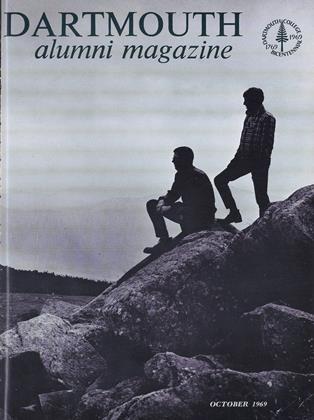THE PACIFIC SALMON FISHERIES, A STUDY OF IRRATIONAL CONSERVATION.
OCTOBER 1969 ELLIS O. BRIGGS '21By James A. Crutchfield andGiulio Pontecorvo '45. Published for Resources for the Future, Inc. by The JohnsHopkins Press, 1969. 220 pp. $6.
Readers of this erudite tale are likely to rush to the nearest market to snatch one last can of salmon, before the noble chinook and sockeye disappear from the seas and abandoned canneries add to the pollution tainting the Pacific Ocean.
Fisheries are beset by "senseless restrictions," declares the foreword, and "there is little hope for a change unless dramatically new institutions and new forms of management" can be adopted. The authors appear to doubt whether these will be forthcoming, or forthcoming in time to save from extinction the Pacific salmon.
The first reason for their pessimism is "open access to the stocks," that is, unrestricted high-seas fishing, tolerable until the industrial revolution but now, owing to destructive modern techniques, menacing one species after another. That is what the Peruvians complain about, viewing the depredations of American tuna clippers off Talara, and what the Americans complain about as we watch Russian trawlers taking "our" cod and haddock, from Cape Cod to Hatteras.
The second reason is that management programs have allegedly been treated as biological rather than as economic problems, with the result that conservation efforts have been irrational and unsuccessful. It is with this thesis — the triumph of the biological over the economic approach — that the authors primarily deal, with a mass of technical detail which may defeat the less than dedicated angler.
The study is one of a series on "resources of the future," a non-profit enterprise financed by the Ford Foundation, which might well have included a layman's translation of the relevance to icthyological conservation of the L=k E (m - k1 / k2 E) where "L is landings, E is fishing effort, and M is maximum population (fishes or fishermen not stated) and k1 and k2 (not otherwise identified) are constants."
The implication seems to be that if the politicos were exterminated, the bureaucrats locked up, and the anadromous biologists sent to Tuck School, the chances of survival of the Pacific salmon would be increased.
The authors may be right, at that.
The Honorable Mr. Briggs is a retiredAmerican Ambassador and a member of theAtlantic Salmon Association.
 View Full Issue
View Full Issue
More From This Issue
-
 Feature
FeatureThird Century Fund Launches General Campaign Among Alumni
October 1969 -
 Feature
FeatureThe Transcending Great Issues
October 1969 -
 Feature
FeatureA Scientific Centennial for Dartmouth
October 1969 By ALLEN L. KING -
 Feature
FeatureWhitewater Racing Gains New Status
October 1969 By JAY EVANS '49 -
 Feature
FeatureBicentennial Draws Unusual Gifts
October 1969 -
 Article
ArticleWith the Big Green Teams
October 1969
ELLIS O. BRIGGS '21
Books
-
 Books
BooksMAUD
January 1940 -
 Books
BooksAlumni Articles
NOVEMBER 1967 -
 Books
BooksThe American Scourge
March 1976 By JACKSON WRIGHT '33 M.D. -
 Books
BooksANALYTIC GEOMETRY,
May 1949 By L. L. Silverman -
 Books
BooksIT'S A WISE PARENT,
November 1945 By M. D. F. -
 Books
BooksMAXIMUM SECURITY WARD.
FEBRUARY 1971 By STEPHEN G. NICHOLS JR. '58






